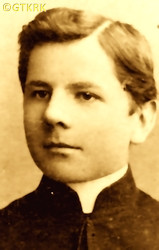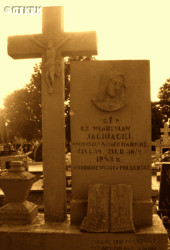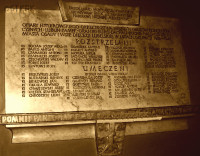Roman Catholic
St Sigismund parish
05-507 Słomczyn
85 Wiślana Str.
Konstancin deanery
Warsaw archdiocese, Poland
full list:
displayClick to display full list

searchClick to search full list by categories
wyświetlKliknij by wyświetlić pełną listę po polsku

szukajKliknij by przeszukać listę wg kategorii po polsku

Martyrology of the clergy — Poland
XX century (1914 – 1989)
personal data
surname
JACNIACKI
forename(s)
Vladislav (pl. Władysław)
function
diocesan priest
creed
Latin (Roman Catholic) Church RCmore on
en.wikipedia.org
[access: 2014.09.21]
diocese / province
Lublin diocesemore on
pl.wikipedia.org
[access: 2013.05.19]
RC Military Ordinariate of Polandmore on
en.wikipedia.org
[access: 2014.12.20]
date and place
of death
08.10.1943

Nabróżtoday: Łaszczów gm., Tomaszów Lubelski pov., Lublin voiv., Poland
more on
en.wikipedia.org
[access: 2021.08.20]
alt. dates and places
of death
29.05.1943, 30.05.1943
details of death
After German and Russian invasion of Poland in 09.1939 and start of the World War II, after start of German occupation, collaborated with Polish clandestine resistance Home Army AK (part of Polish Clandestine State) under nom‐de‐guerre „Mak”.
During the German ethnic cleansing «Aktion Zamość» prob. apprehended by the Germans (his own Nabróż village was spared by many neighbouring villages were pacified) and held in the transit resettlement Zwierzyniec camp.
Prob. released.
Then, after Polish resistance carried out the death sentence on Sergey Zacharczuk, Orthodox priest accused of collaborating with genocidal Ukrainian organization OUN/UPA, went into hiding — returned only after being assured of protection by the Polish partisans.
Murdered during «Genocidium Atrox» — Ukrainian genocide of Poles. At night, nine Ukrainians, members of the genocidal organization OUN/UPA, burst into the parish village.
First, they murdered the headmaster of the local school. Then they stormed the rectory and started shooting.
The priest was shot in the hand and stomach, his sister, a housewife and her 13‐year‐old son — in the head.
Died a few hours after the criminals left.
cause of death
mass murder
perpetrators
Ukrainians
sites and events
«Genocidium Atrox»Click to display the description, DL ZwierzyniecClick to display the description, «Aktion Zamość»Click to display the description, GeneralgouvernementClick to display the description, Ribbentrop‐MolotovClick to display the description, Pius XI's encyclicalsClick to display the description
date and place
of birth
01.11.1888Birth certification on:
www.familysearch.org
[access: 2025.04.16]

Urzędówtoday: Urzędów gm., Kraśnik pov., Lublin voiv., Poland
more on
en.wikipedia.org
[access: 2021.08.20]
parents
JACNIACKI Francis
🞲 ?, ? — 🕆 ?, ?

JACNIACKA Catherine
🞲 ?, ? — 🕆 ?, ?
baptism
02.11.1888Birth certification on:
www.familysearch.org
[access: 2025.04.16]

Urzędówtoday: Urzędów gm., Kraśnik pov., Lublin voiv., Poland
more on
en.wikipedia.org
[access: 2021.08.20]
St Nicholas the Bishop and Confessor RC church
presbyter (holy orders)
ordination
01.11.1911

positions held
1928 – 1943
parish priest — Nabróżtoday: Łaszczów gm., Tomaszów Lubelski pov., Lublin voiv., Poland
more on
en.wikipedia.org
[access: 2021.08.20] ⋄ Assumption of the Blessed Virgin Mary, St Stanislav the Bishop and Martyr and St Agnes the Martyr RC parish ⋄ Tomaszów Lubelskitoday: Tomaszów Lubelski gm., Tomaszów Lubelski pov., Lublin voiv., Poland
more on
en.wikipedia.org
[access: 2021.08.20] RC deanery
1920 – 1928
parish priest — Rachanietoday: Rachanie gm., Tomaszów Lubelski pov., Lublin voiv., Poland
more on
en.wikipedia.org
[access: 2021.08.20] ⋄ Transfiguration of the Lord RC parish ⋄ Tomaszów Lubelskitoday: Tomaszów Lubelski gm., Tomaszów Lubelski pov., Lublin voiv., Poland
more on
en.wikipedia.org
[access: 2021.08.20] RC deanery
1919 – 1920
parish priest — Susiectoday: Susiec gm., Tomaszów Lubelski pov., Lublin voiv., Poland
more on
en.wikipedia.org
[access: 2021.08.20] ⋄ St John of Nepomuk the Martyr RC parish ⋄ Tomaszów Lubelskitoday: Tomaszów Lubelski gm., Tomaszów Lubelski pov., Lublin voiv., Poland
more on
en.wikipedia.org
[access: 2021.08.20] RC deanery
1919
vicar — Tomaszów Lubelskitoday: Tomaszów Lubelski gm., Tomaszów Lubelski pov., Lublin voiv., Poland
more on
en.wikipedia.org
[access: 2021.08.20] ⋄ Annunciation to the Blessed Virgin Mary RC parish ⋄ Tomaszów Lubelskitoday: Tomaszów Lubelski gm., Tomaszów Lubelski pov., Lublin voiv., Poland
more on
en.wikipedia.org
[access: 2021.08.20] RC deanery
c. 1917 – 1919
vicar — Łukowatoday: Łukowa gm., Biłgoraj pov., Lublin voiv., Poland
more on
en.wikipedia.org
[access: 2021.08.20] ⋄ Assumption of the Blessed Virgin Mary RC parish ⋄ Biłgorajtoday: Biłgoraj urban gm., Biłgoraj pov., Lublin voiv., Poland
more on
en.wikipedia.org
[access: 2020.12.03] RC deanery
1911 – 1916
vicar — Tarnogródtoday: Tarnogród gm., Biłgoraj pov., Lublin voiv., Poland
more on
en.wikipedia.org
[access: 2020.11.27] ⋄ Transfiguration of the Lord RC parish ⋄ Biłgorajtoday: Biłgoraj urban gm., Biłgoraj pov., Lublin voiv., Poland
more on
en.wikipedia.org
[access: 2020.12.03] RC deanery
till 1911
student — Lublintoday: Lublin city pov., Lublin voiv., Poland
more on
en.wikipedia.org
[access: 2021.08.20] ⋄ philosophy and theology, Theological Seminary
others related
in death
ZACHARCZUKClick to display biography Sergius
sites and events
descriptions
«Genocidium Atrox»: In 1939‐1947, especially in 1943‐1944, independent Ukrainian units, mainly belonging to genocidal Ukrainian organizations OUN (political arm) and UPA (military arm), supported by local Ukrainian population, murdered — often in extremely brutal way — in Volyn and surrounding regions of pre‐war Poland, from 130,000 to 180,000 Poles, all civilians: men, women, children, old and young. Polish‐Ukrainian conflict that openly emerged during and after World War I (in particular resulting in Polish‐Ukrainian war of 1918‐1919), that survived and even deepened later when western Ukraine became a part Poland, exploded again after the outbreak of the World War II in 09.1939. During Russian occupation of 1939‐1941, when hundreds of thousands of Poles were deported into central Russia, when tens of thousands were murdered (during so‐called Katyń massacres, among others), this open conflict had a limited character, helped by the fact that at that time Ukrainians, Ukrainian nationalists in particular, were also persecuted by the Russians. The worst came after German‐Russian war started on 22.06.1941 and German occupation resulted. Initially Ukrainians supported Germans (Ukrainian police was initiated, Ukrainians co—participated in extermination of the Jews and were joining army units fighting alongside Germans). Later when German ambivalent position towards Ukraine became apparent Ukrainians started acting independently. And in 1943 one of the units of aforementioned Ukrainian OUN/UPA organization, in Volyn, started and perpetrated a genocide of Polish population of this region. In mere few weeks OUN/UPA murdered, with Germans passively watching on the sidelines, more than 40,000 Poles. This strategy was consequently approved and adopted by all OUN/UPA organisations and similar genocides took place in Eastern Lesser Poland (part of Ukraine) where more than 20,000 Poles were slaughtered, meeting however with growing resistance from Polish population. Further west, in Chełm, Rzeszów, etc. regions this genocide turned into an extremely bloody conflict. In general genocide, perpetrated by Ukrainian nationalists, partly collaborating with German occupants, on vulnerable Polish population took part in hundreds of villages and small towns, where virtually all Polish inhabitants were wiped out. More than 200 priests, religious and nuns perished in this holocaust — known as «Genocidium Atrox» (Eng. „savage genocide”) The nature and purpose of genocide is perhaps best reflected in the song sung by the murderers: „We will slaughter the Poles, we will cut down the Jews, we must conquer the great Ukraine” (ukr. „Поляків виріжем, Євреїв видусим, велику Україну здобути мусим”). This holocaust and conflict ended up in total elimination of Polish population and Polish culture from Ukraine, in enforced deportations in 1944‐1945 of remaining Poles from Ukraine and some Ukrainians into Ukraine proper, and finally in deportation of Ukrainians from East‐South to the Western parts of Polish republic prl by Commie‐Nazi Russian controlled Polish security forces („Vistula Action”). (more on: www.swzygmunt.knc.plClick to attempt to display webpage
[access: 2021.06.20])
DL Zwierzyniec: Germ. Durchgangslager Zwierzyniec (Eng. Transit Camp), set up by Germans in 1940. Initially held Poles selected for slave labour in Germany. From 1942 to 1943 Germ. Aussiedlerlager (Eng. Repatriation Camp) — Poles from Zamojszczyzna region were held captive there — as part of so‐called «Aktion Zamość» during which c. 100‐110 thousands of victims, including c. 30,000 children (part of the genocidal robbery of children targeted for Germanization) were evicted from their homes. On average camp had c. 15,000 prisoners. Altogether c. 24,000 Poles — men, women and children — were held there. In the camp selection was carried out into 5 categories of victims: „WE” — having nording „ratial features”, targetted for „Germanisation” — transported to a special camp in Łódź; „AA” — sent out for slave labour, mainly in Germany; „KI” — children up to 14 years on, targetted for Germanisation in Germany; „KL” — transported to German concentration camps, mainly KL Majdanek and KL Auschwitz (c. 21%); „RD”— above 60 years old, and others, targeted for work for German colonizers. (more on: en.wikipedia.orgClick to attempt to display webpage
[access: 2021.12.19])
«Aktion Zamość»: On 11.1942, the Germans began «Aktion Zamość» — a series of forced resettlement, an ethnic cleansing actions of the Polish population and pacification of Polish villages carried out in the Zamość region, in the territory of the Germ. Generalgouvernement (Eng. General Governorate) occupied by Germans, under the Germ. Generalplan Ost GPO (Eng. General Plan East), i.e. the plan of German settlement and Germanization of territories in Central and Eastern Europe. Until 08.1943, it covered a total of 100,000‐110,000 displaced Poles, including 30,000 children (some of them were taken from their parents and semt for a forced Germanization in German families) — most of them passed through the special Germ. UWZ Lager Zamość (Eng. resettlement camp in Zamość), where selection took place, e.g. group IV, children separated from parents. In place of the displaced, it was intended to settle 60,000 German colonists from Bessarabia, Ukraine, Bosnia, Serbia, Slovenia and Russia. In the first phase (28.11.1942‐03.1943) 116 villages were forcibly displaced — the displacements were carried out by Germ. Schutzpolizei units or the gendarmerie, with the help of the Ukrainian Auxiliary Police collaborating with Germany; in the second, as part of the so‐called Aktion Werwolf (06.1943‐08.1943) — 171 villages — the displacements were supervised by Wehrmacht and Waffen‐SS units, supported by the employees of UWZ Lager Zamość. As a result of the actions of the Polish resistance movement — during the so‐called Zamość Uprising, Polish partisans fought several large battles with the overwhelming German forces — 293 villages were displaced out of the 696 planned. In some villages Germans settled resettled Ukrainians — during the so‐called Ukraineraktion — under control of collaborating with Germans Ukrainian Support Committees among others. (more on: en.wikipedia.orgClick to attempt to display webpage
[access: 2021.08.20], journals.umcs.plClick to attempt to display webpage
[access: 2021.08.20])
Generalgouvernement: After the Polish defeat in the 09.1939 campaign, which was the result of the Ribbentrop‐Molotov Pact and constituted the first stage of World War II, and the beginning of German occupation in part of Poland (in the other, eastern part of Poland, the Russian occupation began), the Germans divided the occupied Polish territory into five main regions. In two of them new German provinces were created, two other were incorporated into other provinces. However, the fifth part was treated separately, and in a political sense it was supposed to recreate the German idea from 1915 (during World War I, after the defeat of the Russians in the Battle of Gorlice in 05.1915) of creating a Polish enclave within Germany. Illegal in the sense of international law, i.e. Hague Convention, and public law, managed by the Germans according to separate laws — especially established for the Polish Germ. Untermenschen (Eng. subhumans) — till the Russian offensive in 1945 it constituted part of the Germ. Großdeutschland (Eng. Greater Germany). Till 31.07.1940 formally called Germ. Generalgouvernement für die besetzten polnischen Gebiete (Eng. General Government for the occupied Polish lands) — later simply Germ. Generalgouvernement (Eng. General Governorate), as in the years 1915‐1918. From 07.1941, i.e. after the German attack on 22.06.1941 against the erstwhile ally, the Russians, it also included the Galicia district, i.e. the Polish pre‐war south‐eastern voivodeships. A special criminal law was enacted and applied to Poles and Jews, allowing for the arbitrary administration of the death penalty regardless of the age of the „perpetrator”, and sanctioning the use of collective responsibility. After the end of the military conflict of the World War UU, the government of the Germ. Generalgouvernement was recognized as a criminal organization, and its leader, governor Hans Frank, guilty of war crimes and crimes against humanity and executed. (more on: en.wikipedia.orgClick to attempt to display webpage
[access: 2024.12.13])
Ribbentrop‐Molotov: Genocidal Russian‐German alliance pact between Russian leader Joseph Stalin and German leader Adolf Hitler signed on 23.08.1939 in Moscow by respective foreign ministers, Mr. Vyacheslav Molotov for Russia and Joachim von Ribbentrop for Germany. The pact sanctioned and was the direct cause of joint Russian and German invasion of Poland and the outbreak of the World War II in 09.1939. In a political sense, the pact was an attempt to restore the status quo ante before 1914, with one exception, namely the „commercial” exchange of the so‐called „Kingdom of Poland”, which in 1914 was part of the Russian Empire, fore Eastern Galicia (today's western Ukraine), in 1914 belonging to the Austro‐Hungarian Empire. Galicia, including Lviv, was to be taken over by the Russians, the „Kingdom of Poland” — under the name of the General Governorate — Germany. The resultant „war was one of the greatest calamities and dramas of humanity in history, for two atheistic and anti‐Christian ideologies — national and international socialism — rejected God and His fifth Decalogue commandment: Thou shall not kill!” (Abp Stanislav Gądecki, 01.09.2019). The decisions taken — backed up by the betrayal of the formal allies of Poland, France and Germany, which on 12.09.1939, at a joint conference in Abbeville, decided not to provide aid to attacked Poland and not to take military action against Germany (a clear breach of treaty obligations with Poland) — were on 28.09.1939 slightly altered and made more precise when a treaty on „German‐Russian boundaries and friendship” was agreed by the same murderous signatories. One of its findings was establishment of spheres of influence in Central and Eastern Europe and in consequence IV partition of Poland. In one of its secret annexes agreed, that: „the Signatories will not tolerate on its respective territories any Polish propaganda that affects the territory of the other Side. On their respective territories they will suppress all such propaganda and inform each other of the measures taken to accomplish it”. The agreements resulted in a series of meeting between two genocidal organization representing both sides — German Gestapo and Russian NKVD when coordination of efforts to exterminate Polish intelligentsia and Polish leading classes (in Germany called «Intelligenzaktion», in Russia took the form of Katyń massacres) where discussed. Resulted in deaths of hundreds of thousands of Polish intelligentsia, including thousands of priests presented here, and tens of millions of ordinary people,. The results of this Russian‐German pact lasted till 1989 and are still in evidence even today. (more on: en.wikipedia.orgClick to attempt to display webpage
[access: 2015.09.30])
Pius XI's encyclicals: Facing the creation of two totalitarian systems in Europe, which seemed to compete with each other, though there were more similarities than contradictions between them, Pope Pius XI issued in 03.1937 (within 5 days) two encyclicals. In the „Mit brennender Sorge” (Eng. „With Burning Concern”) published on 14.03.1938, condemned the national socialism prevailing in Germany. The Pope wrote: „Whoever, following the old Germanic‐pre‐Christian beliefs, puts various impersonal fate in the place of a personal God, denies the wisdom of God and Providence […], whoever exalts earthly values: race or nation, or state, or state system, representatives of state power or other fundamental values of human society, […] and makes them the highest standard of all values, including religious ones, and idolizes them, this one […] is far from true faith in God and from a worldview corresponding to such faith”. On 19.03.1937, published „Divini Redemptoris” (Eng. „Divine Redeemer”), in which criticized Russian communism, dialectical materialism and the class struggle theory. The Pope wrote: „Communism deprives man of freedom, and therefore the spiritual basis of all life norms. It deprives the human person of all his dignity and any moral support with which he could resist the onslaught of blind passions […] This is the new gospel that Bolshevik and godless communism preaches as a message of salvation and redemption of humanity”… Pius XI demanded that the established human law be subjected to the natural law of God , recommended the implementation of the ideal of a Christian state and society, and called on Catholics to resist. Two years later, National Socialist Germany and Communist Russia came together and started World War II. (more on: www.vatican.vaClick to attempt to display webpage
[access: 2023.05.28], www.vatican.vaClick to attempt to display webpage
[access: 2023.05.28])
sources
personal:
nawolyniu.plClick to attempt to display webpage
[access: 2013.01.06], www.kresykedzierzynkozle.home.plClick to attempt to display webpage
[access: 2013.01.13], www.familysearch.orgClick to attempt to display webpage
[access: 2025.04.16], www.ospnabroz.plClick to attempt to display webpage
[access: 2013.01.13], roberthorbaczewski.plClick to attempt to display webpage
[access: 2014.08.14]
bibliographical:
„Mysterium iniquitatis. Clergy and religious of the Latin rite murdered by Ukrainian nationalists in 1939‐1945”, Fr Józef Marecki, Institute of National Remembrance IPN, Kraków 2020
original images:
www.facebook.comClick to attempt to display webpage
[access: 2023.08.19], www.rodzinakulik.euClick to attempt to display webpage
[access: 2012.12.28], www.miejscapamiecinarodowej.plClick to attempt to display webpage
[access: 2014.05.09]
LETTER to CUSTODIAN/ADMINISTRATOR
If you have an Email client on your communicator/computer — such as Mozilla Thunderbird, Windows Mail or Microsoft Outlook, described at WikipediaPatrz:
en.wikipedia.org, among others — try the link below, please:
LETTER to CUSTODIAN/ADMINISTRATORClick and try to call your own Email client
If however you do not run such a client or the above link is not active please send an email to the Custodian/Administrator using your account — in your customary email/correspondence engine — at the following address:

giving the following as the subject:
MARTYROLOGY: JACNIACKI Vladislav
To return to the biography press below:
 Click to return to biography
Click to return to biography










